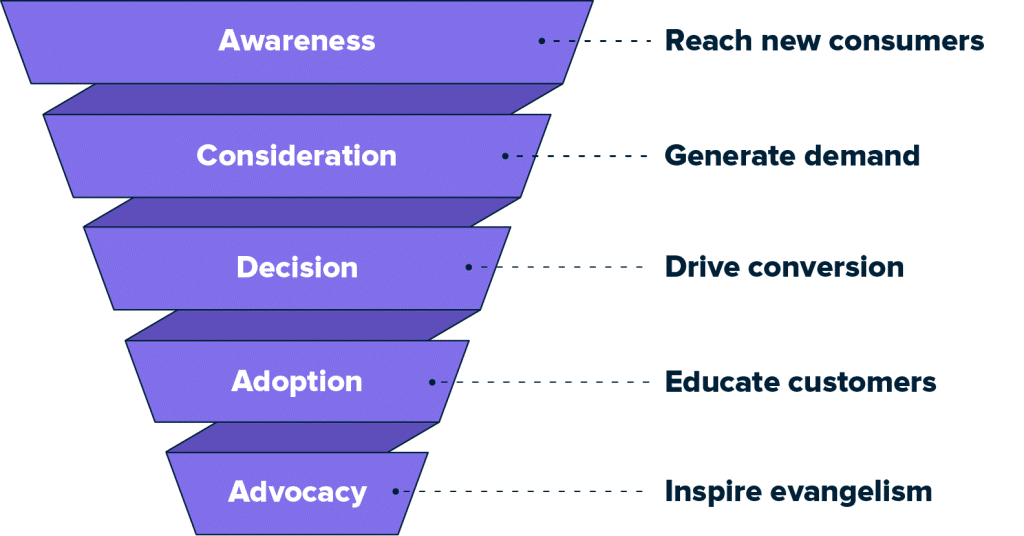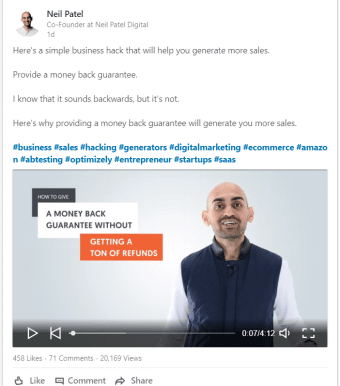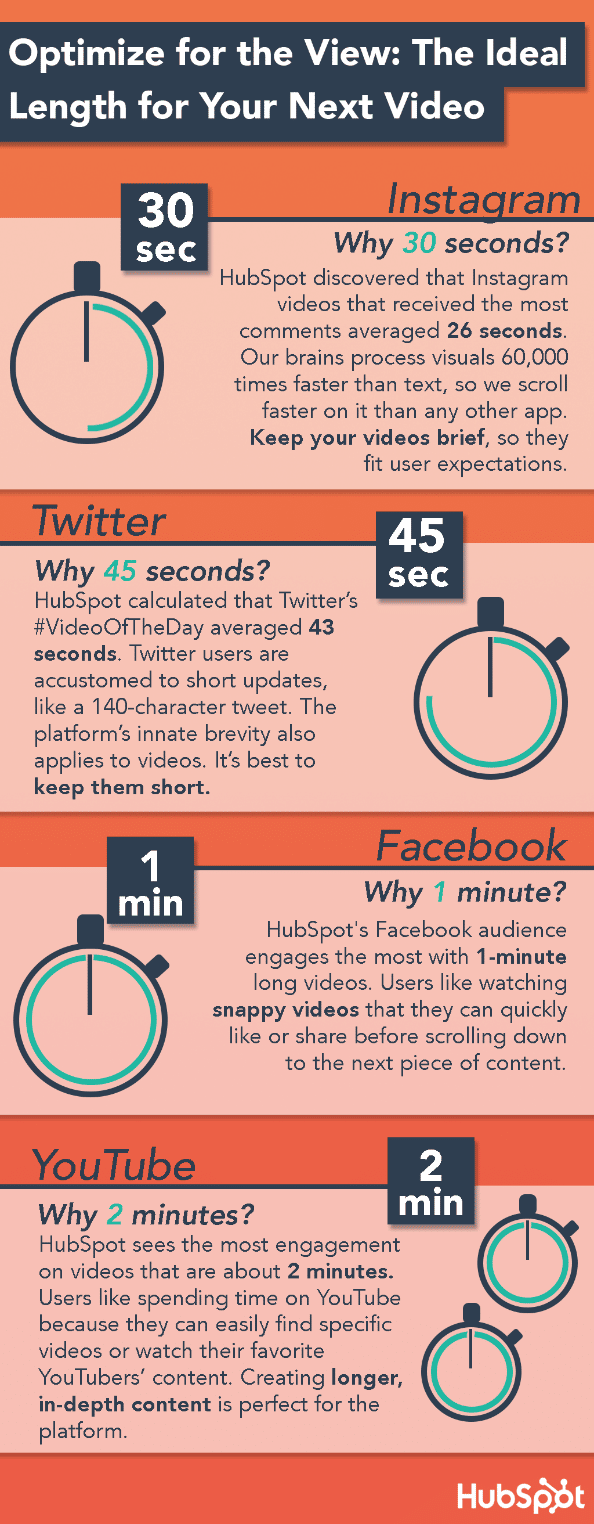
Video Content Marketing: The Key to Audience Growth & Retention
A picture speaks a thousand words – but video content marketing attracts and engages users even better. One study found that visitors spend 88% more time on a website with video.
If you’re a switched-on marketer, that’s one statistic you cannot afford to ignore.
Critically, video content marketing blurs the line between entertainment and outright advertising. In short, video is convenient, video is valuable, and video is fun.
Whether you want to tell a powerful story, make people laugh, or show viewers you understand what they’re facing and have the tools to help, you can – with video. That said, we all know that video content marketing and video production do not just happen overnight. They also do not happen without any effort.
But before we jump in,
Quick Takeaways:
- Video content marketing involves creating and distributing branded video with the goal of converting users.
- Businesses have access to many video hosting platforms beyond YouTube, many with unique offerings.
- Web pages with video are favored in search engine results, so you want to add more video to your site.
- Your video content marketing efforts will be amplified if you follow these best practices for publishing and promoting them.
What Is Video Content Marketing?
Video content marketing involves the creation and distribution of valuable, branded video content to a target audience, with the goal of raising awareness and engaging and converting leads.
Much the same as typical content marketing, video content marketing is a marketing approach that aims to fulfill buyer needs, answer their questions, and, ultimately, drive more business.
It’s about figuring out how video can be integrated into each stage of the buying process and that every channel you brand is active on. The content must be useful, valuable, and entertaining – you want your audience to engage with you again, to take the next step.
Video content marketing is strategic. It’s more than sporadically producing and publishing disconnected videos across random channels on an inconsistent schedule. Successful video marketing involves research, planning, and optimization.
But Why Video?
Video has long been touted as one of the biggest things in marketing. It enables businesses and brands to project their personality, to showcase the very human team behind the logo, and to build a genuine connection.
Video marketing can be a powerful way to reach new prospects and provide extra value to new and long-term customers alike. It’s an opportunity to highlight the features of a product, to explain how something works in a quick, visual, easily-digestible chunk of marketing gold. Not only is video educational and entertaining, but it can help your business connect with your target audience on a deeper level. Videos are easy to digest, can help people understand your business better, and will bring life and motion to your content and messaging.
Here are several impressive video marketing stats:
- 86% of businesses use video for marketing. 93% say it’s an integral part of their strategy.
- 78% say it directly helps increase sales, and 84% say it’s helped generate leads.
- 87% of video marketers say video gives them a positive return on investment.
- 94% believe video helps consumers better understand their product or service.
Video is a unique medium that lends itself fantastically to established content marketing strategies. Here are some of the stand-out features of video that make it relevant to today’s consumer:
- Video is easy to digest. Most of us scroll through our phones for, on average, 3.3 hours a day. Video stands out because it’s quick and requires no effort to consume.
- Video is entertaining. Watching someone demonstrate how a manual coffee grinder works, for example, provides greater entertainment value than, say, a text-based step-by-step guide or manual.
- Video is engaging. There’s a reason why people spend most of their time online watching videos on a daily basis – it’s valuable and fun, two traits that lead to impressive engagement levels.
- Video is highly accessible. It can be published across all social media platforms, as well as embedded into web pages.

Likely, you already know all this. Perhaps you’ve already dabbled in video creation. Now, it’s about bridging the gap between the videos saved on your hard drive, or stored on your YouTube channel, and the lead-generating strategy you are attempting to execute.
Many brands have loads of videos. They just don’t know how to maximize them for impact on search and social. So the questions I want to answer today:
- Where should we post our video content?
- How to promote my YouTube videos?
- How to promote videos on LinkedIn?
Here’s an overview of developing a video marketing strategy that will help you effectively grow your audience on your chosen social media channels.
Set Goals
Your goals will influence the types of videos you create and where those videos are shared. Keep the following in mind when goal setting:
- Be specific. Determine whether you want to generate awareness, gather new leads, or convert qualified leads into customers, as examples.
- Define the measurables. How will you determine the success of your campaign? Identify key metrics, such as views, engagements, or conversion rate.
- Consider the timing. Establishing a realistic deadline is critical to your marketing efforts. Keep possible obstacles and risks in mind and be sure to pivot your expectations accordingly.
- Identify your audience. Use demographic, behavioral, and customer journey metrics to identify the target audience of your campaign.
- Complementary assets. Will you need blog posts and social media updates to go alongside your video? Be sure to include these in your plan of action.
Consider your marketing funnel when setting specific, measurable, attainable, relevant, and timely (SMART) goals for your video marketing strategy. For example, if your goal is to “increase the number of followers you have on Facebook to 10,000 by the end of the year,” your video strategy will probably fall into the awareness stage.
Once you reach new prospects and get them interested in your business, you’ll also need video content that falls into the consideration stage, and so on.

Choose Your Platforms
If you’re just starting out with video, start creating content for social media channels where you already have a solid audience. You’ll have to format your videos differently depending on the channel. Remember that each one serves a different purpose. Choose the platform(s) that best align with your business goals, industry, market, and audience potential.
The videos you create and the strategy behind them are important, but so, too, is where those videos are published.
When comparing video hosting sites, keep an eye out for the following features:
- An intuitive interface
- Compatibility with mobile devices
- Compatibility with all types of players and browsers
- Analytics tools to measure the performance of your videos
- The ability to embed your videos on websites
- Search engine optimization tools
Where should you publish your video content? Most of us little folks just use YouTube. But if you are looking for a more elegant solution, here are nine video platforms to explore:
1. YouTube
YouTube is well-known, popular, and has significant existing viewership. YouTube is free and allows creators to earn money via its ad-supported monetization program. YouTube is usually the default choice for businesses, and this isn’t such a bad thing – videos hosted on YouTube are given priority in Google search results. And it is easy to promote them.
Which may be part of the problem. You don’t want to send all your traffic to YouTube so THEY can advertise to YOUR audience. You want to bring those people to your website. Which is why we wrote this article in the first place. (Don’t worry, you can jump to how to promote your YouTube video.)
2. Vimeo
Vimeo began just like YouTube – as a basic video-sharing platform. Today, its functionalities enable businesses to collaborate with team members, customize video players, and access marketing features like analytics. If collaboration is a top priority, Vimeo might be the right choice.
3. Wistia
Wistia focuses on delivering marketing features that assist businesses in tracking their video’s performance, enabling them to optimize their campaigns to generate the highest possible return on investment. One of the platform’s flagship features is the Turnstile email collector, which allows you to collect viewers’ email addresses right from your video.
Wistia also has great resources about videos on their platform. Their article on how to use video content marketing to increase SEO traffic is golden! And I love this video about shooting video from your iPhone.
4. Vidyard
Vidyard’s selling points are its ease-of-use and excellent customer service. The Vidyard team is happy to work with you to help you create and publish high-quality content.
5. Brightcove
Brightcove offers basic customization that enables you to brand your videos consistently. You can add your business’s name, logo, colors, and more. These details can be saved and used again and again, ensuring all of your content across a campaign has the same look and feel.
6. Hippo Video
Hippo Video is unique in that it allows you to send personalized videos to your audience in bulk. You can add an individual’s name, email, and more – and then send out to as many customers or prospects as you like in one swoop.
7. Spotlightr
For highly detailed analytics that shed light on your video’s progress and your viewers’ demographics and behaviors, Spotlightr (formerly, vooPlayer) is an excellent choice. The platform offers reports based on a whole host of variables, including play rate, completion, viewer location, engagement, and more.
8. SproutVideo
SproutVideo helps you create basic websites – or landing pages – around your hosted video content. These websites can then be used to showcase a portfolio, share tutorials, or even provide video instructions to your team members.
9. Uscreen
Uscreen has a system in place that allows you to make money off of your videos without exposing your audience to ads. You do have to pay a flat monthly fee, however.
Decide Which Types of Videos to Create
With goals established, you can determine the types of videos that’ll best assist you in achieving those goals. The most commonly created video types are social media videos, ads, presentation videos, sales videos, and explainer videos. Here are several other popular options to consider:
- Vlogs
- Interviews
- Testimonial videos that provide all-important social proof
- Product videos that showcase features and functionalities
- Videos that tell your brand story
- Animations that are short, engaging, and playful or slideshow-style videos that are quick to put together
- Company culture or behind-the-scenes videos
- Educational videos that highlight your industry expertise and authority
- Video emails that add a new dimension to your eDMs
- Webinars
- Product reviews
- Live videos
- Demos
- Case studies
- Virtual reality videos
- Personalized messages
Create or Produce Videos
Some of the obvious things coming to mind are video production or video acquisition.
For those of you who are already video producers, think you are video producers, or are the fearless types, this step probably doesn’t hang you up that much.
However, there is another group of people who may wonder how you are going to come by the video in the first place. I am not suggesting that you worry about it, but rather, evaluate your options.
Here are three ideas right from the starting gate:
- Produce the video yourself.
- Purchase the video.
- Hire someone to make the video for you.
1: Do-It-Yourself Videos
Here are a few tips to guide you toward excellent video content:
- Prioritize quality. Poor-quality video doesn’t send the right message. Instead, invest in proper camera equipment and editing software (or hire someone).
- Show your personality (if it matches your brand). If you or a team member is getting in front of the camera, let your quirks show. People want to connect with people – not businesses.
- Speak slowly and add captions. If you talk too fast, it’s likely that your message will get lost. Also, keep in mind that many people watch video with the sound off – captions are essential.
- Brand your videos. Be sure the look and feel of your video content aligns with your brand.
- Add a call to action. If a viewer wants to learn more or take the next step, make it easy for them with a clear, visual CTA.
If you already have the experience and the video software, then the expense is a different focus. It is more about video production and the time involved in getting it done. If you do not yet have the software, there is going to be the cost of the software. However, that doesn’t mean that you have to spend a ton of money.
On the low end of the spectrum, there are some video software packages that may cross your email that range around $30 or so. Granted, they may not be top of the line, but it gets the job done, and that is the goal here.
Moving up that ladder are software packages like Techsmith’s Camtasia, available for Mac or Windows (at very different costs and capabilities). This is a really good option for the midlevel. You can create some really professional results with this software without having to take a second mortgage on the house. Granted, it will likely require some focused time to learn how to use the software.
If you are a little lower on funds and time, another option for the do-it-yourselfer is to create a live video. Fortunately, with the option of the Google Hangout and the Facebook Live, there is the opportunity to create a video of you chatting with your audience or another individual or team.
While it is great to add that polish to the live video, there is a bit of forgiveness for the raw element of the live video. This creates a focus on the content and less about the production skill set. This allows for less time (in production) and less money (not requiring the professional software).
2: Purchasing Ready-Made Videos
Another option for obtaining/acquiring that video is to purchase it.
This can be done at sites like Big Stock Photo, where the price of the videos, considering the high quality, is pretty reasonable, or many other similar stock image/video sites.
Technically, you could use the video “as is” after purchasing it on a stock site. However, more than likely you will want to combine this method with Method #1, the do-it-yourself. You will likely want to combine the video with a bit of production process, adding some text and animation, etc. Fortunately, Camtasia allows the adding of text/animation. There are also lower dollar applications that do it, too.
There are online options that provide how-to mechanisms and functionality. Those would include Sparkol (VideoScribe) for whiteboard/explainer videos and PowToon for animations.
One other area of purchase is PLR, which stands for “Private Label Rights.” In some cases, people will create videos and sell them to others. The buyers use the videos in membership sites, articles, or other video marketing endeavors. The best PLR to consider is sold as a limited edition product. That means that there are fewer people out there who are using the same video or set of videos. However, the advantage of PLR is that the price reflects the bulk access of the videos. Because of that, you could acquire videos in a cost saving transaction.
3: Hire a Professional to Create Videos
Finally, there is the option of hiring a professional videographer and/or a professional video marketer to produce and market your video for you.
When hiring quality service, this can be very expensive, and it is not surprising that it can reach the five digits in pricing. Quality service costs money, considering the cost of production, the electricity, the skill, etc.
On the other end of the spectrum, there are those who will advertise professional video services for $5. Yes, you got it, at places like Fiverr. Two of the categories that come to mind are Whiteboard/Explainer Videos and a search that involves a service, like “do a whiteboard video.”
The key thing to keep in mind, when hiring a professional is that you do get what you are paying for in the service. So, while the person charging $5 may be very talented, you are not likely to get the $5,000 service for $5.
As long as you can manage your expectations, this may be a viable option for you, realizing that low dollar may mean a bit lower quality.
Optimize Your Videos for Search
After creating the right video content for the proper channels, it’s time to share them with your audience. Optimize every video you make for search engines so you can attract more traffic and build your audience organically. Here are some tips:
- Incorporate target keywords where appropriate.
- Insert transcripts.
- Create engaging thumbnail images.
- Carefully craft titles and video descriptions.
- Avoid embedding the same video in multiple locations.
Promote New Videos on Social
After you publish and optimize your video content, promote it to increase visibility. For example, you could promote one video multiple times using different clips. You can also promote the same video on the same platform various times throughout the year so new followers will see it and engage.
Video Marketing on Major Social Networks
It’s no surprise that different types of videos perform better on different social media channels. This is because each channel has a distinct consumer base and serves a unique purpose. Here are the top six channels for promoting your video content marketing today and how to use them to grow your online audience.
1. Facebook
The ease of video accessibility in recent years is changing the nature of what defines the concept of marketing. Mark Zuckerberg himself claimed a couple years ago that he imagines the majority of online content will be video in the near future. This statement is clearly reflected in his own platform, as the new Facebook algorithm now heavily favors video content.
The top users on Facebook are between ages 25 and 34, and 56% are male. Despite all the competition and controversies happening on this channel today, it remains the most widely used social media platform – with 2.7 billion monthly active users. People use Facebook for entertainment, fun, inspiration, and to reshare content with others.
If you plan to publish videos on Facebook (which we highly recommend), plan on creating them so viewers can watch with or without sound. That means your videos (for most channels in this list) should have captions or helpful text explaining what’s happening as it plays. Facebook, specifically, has a silent auto-play feature. So when people are scrolling down their feed, videos will start playing automatically.
On Facebook, longer videos perform well. Make sure you upload your videos directly to the platform for maximum reach. And ensure your content is highly relevant to your audience. Brand awareness videos tend to perform well on Facebook, too – especially if they’re entertaining and lighthearted.
2. Instagram
Instagram continues growing steadily – with 1 billion monthly active users. Its largest age group is the same as Facebook’s, but 57% are female. Instagram can be a brilliant place to advertise and market to higher-earning demographics.
Like Facebook, Instagram plays videos automatically without sound. Try to grab users’ attention instantly in your video content marketing. Make your videos visually eye-catching and engaging. Right off the bat, incorporate motion to engage viewers. Then supplement with text so users can watch whether they turn up the audio or not. Also try to take advantage of Stories, IGTV, Reels, and Lives to increase engagement and build a more significant following.
3. X
One hundred eighty-seven million people use X every day. The largest demographic is 30 to 49-year-old males. Many are highly educated and high earners. Even after the change in leadership and the ensuing debates, it’s still a top platform for following current events and breaking news, and driving discussions. X is also a great place for users to consume social and educational video content.
Businesses should use video on X to promote new resources, tell stories, engage with a dedicated audience, and drive website traffic. Videos should be short “teasers” that are easy and quick to consume. You might also consider creating personalized videos to engage with followers in a creative way, one-on-one. Your overarching goal here should be to humanize your brand.
4. YouTube
Over 500 hours of content are uploaded to YouTube every minute. Every month, the channel has over 2 billion logged-in users. The largest age group of users consists of 15 to 25-year-olds. In addition, 72% of all internet users use the channel, and 62% log in daily. Every day, people watch over a billion hours of video. These massive numbers make for enormous marketing opportunities.

On YouTube, you can create a library of video content for your followers. By creating and publishing quality, creative, and educational content on a channel that your audience is seeking, you can grow a successful platform with a dedicated subscriber base.
YouTube is also an excellent channel for building brand awareness. If your goal is to drive traffic back to your website, be strategic about how you produce, upload, and optimize your videos. You can also embed YouTube videos on your website.
5. LinkedIn
LinkedIn is almost split 50-50 between male and female users. The largest age group is older than many other platforms, between 46 and 55. Millennials also make up a large group of LinkedIn users, so don’t overlook them in your marketing. The audience is primarily B2B, highly educated, and higher earning. It can be an excellent network for generating quality leads and growing an international audience.
Today, businesses can directly upload videos and share creative content with their communities on LinkedIn. Here are some ideas for successful video content to share on this platform:
- Showcase new technology.
- Share tutorials on how to use a new product or service.
- Share quick tips, hacks, or research you’ve recently discovered.
- Teach your audience how to solve a common problem.
- Share videos of events or conferences you attend.
- Share thought leadership.
- Share company or industry news, or weigh in on a recent announcement.
6. TikTok
The largest group of TikTok users is 59% female and between the ages of 18 and 24. Gen Z spends a lot of time on this platform daily – over 45 minutes (21.5 hours per month in 2020). While its current demographic is predominantly teens and young adults, adults are starting to use it more (which may present more business opportunities in the future).
TikTok can be a good place to grow your influence. If you have a younger customer base, consider adding this channel to your list. You can share business tips, inspirational videos, and trending content. Try to share a mix of trending and evergreen content for maximum results.
Tips to Grow Your Audience on Social Media Using Videos
To get maximum results from your video content marketing efforts on social media, you’ll need to get a little creative. Here are some tips to help you start thinking outside the box to grow your audience and boost leads and sales for your business.
- Proactively engage with your audience: Proactively listen and respond to your online audience. Carefully monitor comments, shares, messages, and other interactions so you can respond promptly and thoughtfully. The more you can make your online community feel seen and heard, the better chance you’ll have at building a loyal, raving fanbase. Also use hashtags and encourage people to share and tag your business online to expand your reach further.
- Use humor when appropriate: Showing a human side to your brand is a great way to connect with your followers on a deeper level. Ensure it matches your brand tone, personality, and audience.
- Don’t pay for followers: Purchasing fans may seem like a shortcut to a more extensive following, but it’s a bad practice that can get your business into deep trouble. You could gain robot, inauthentic, and disinterested followers that likely won’t stay invested in your business over the long haul.
- Give people a good reason to follow you: And continue giving them reasons to follow and engage with your brand as your audience grows and matures. Tailor your content to address unique audiences on every social media channel rather than using generic content across the board. Being strategic and providing value in every post will help you entice and resonate better with the right audiences online.
Analyze Your Results
If you’re getting great results through video marketing, it likely means you’re connecting well with your target audience. To understand what kind of impact your video content is having, try tracking these metrics:
- Views: The number of times your video has been viewed (also called a reach)
- Clicks: How often viewers click on your calls to action to engage with you further (e.g., a link that leads to your website)
- Click-through rate: The number of times a CTA is clicked divided by the total number of views
- Shares: How many times a video has been shared on social media (exposing you to a larger audience)
- Play rate: The percentage of people who played a video divided by the number of impressions it received
- Completion rate: The number of people who watched your entire video out of the number of people who played it
The higher these numbers are, the more engaged your audience is. They can be direct measures of success. If you do not see the kind of results you want, you may need to adjust your strategy. Consider trying a different social media channel or switching up your content to align with your overarching goals.
5 Tips to Ace Video Content Marketing
As marketers, we are very fortunate to live in a time when making a video doesn’t require heavy-duty cameras, microphones, world-class actors, fancy editing tools, etc. Nowadays, anyone can shoot a decent quality video directly on their smartphone or with some entry level equipment.
Hopefully by now, at the very least, you have experimented a bit here and there with video content. If the marketing landscape keeps moving in the same direction, video will likely need to be the centerfold of your content marketing strategy. Here are some tips to keep in mind as you make the shift.
1. Know How to Repurpose Existing Content
If you have been on the content marketing train for a while now, you probably have a great library of branded content built up. Most likely, this includes things like blog posts, infographics, guides, whitepapers, research, and more.
Now, if you’ve dedicated a decent chunk of your library to evergreen content, you can repurpose these posts into videos. For example, if you wrote a blog post giving readers advice on how to manage a sales team, this can be repurposed into a video. Here is a great example of how you can do this:
According to The State of Video Marketing in 2018, 81% of businesses use video as a marketing tool, a number that is up from 63% from the 2017 report. Simply put, if you want to survive in the current era of marketing, you need to know how to use video at every turn to promote your messaging.
2. Provide Lots of Face Time
Generally speaking, people like to see that brands are human at the end of the day. This is the beauty of video marketing. Whether it’s your company, personal brand, or even a side business, using video allows you to express your messaging in a clear, memorable voice and match it with a face.
It’s no secret that most consumers trust people more than brands. If you put a face in front of your marketing strategy, it will be much easier to connect and relate to the messaging. Take Neil Patel for example. He consistently produces video content of himself giving advice to other marketers.

He does a fantastic job of producing educational video content on his social feeds where he can gain valuable face recognition, promote his expertise, and create strong relationships with his viewers.
Ultimately, face time in your video content works to build trust with your target audience. Therefore, instead of trusting the brand itself, they can put their trust in the person.
3. Diversify Your Channels
The sheer number of content outlets these days is nothing short of amazing. There are so many video-based platforms out there with huge numbers of viewers attached to them. Each channel has its own way of getting people to discover new content.
Chances are, in addition to your website, you are distributing (or plan to distribute) your videos on YouTube. While this is certainly a must, you should also consider releasing your video content on places like Vimeo, Instagram, LinkedIn, Twitter, Periscope, Facebook, etc.
The key is knowing where your customer segments hang out. For instance, if you are a B2B company, you should definitely aim to release your video content on places like Twitter and LinkedIn. If the bulk of your B2C videos are geared towards younger audiences, Instagram and Snapchat should be on your radar. Do some research and find the channels that put you in the best position to reach the most interested eyes. The more you find, the bigger your reach.
4. Keep it Short
Let’s be honest, how many people can actually sit down for an hour or more and watch a marketing video? Probably not many.
Now, you may have a lot of things to say and do in your videos. For example, if you have converted an in-depth how-to piece of content into a video, you may need a long time to get from A to Z. However, while you can certainly release the full version, you can break up the long video into shorter, individual topics. Let’s say you have produced an hour-long video about developing a content marketing plan from scratch. You can split the video up into sections, which could be related to conducting research, choosing target sites for guest posting, reaching out to site editors, and more. By doing this, you are producing 5-10 (or more) pieces of native content, rather than just one long one.
Keep in mind, the major content platforms each have their own sweet spots in terms of video duration. HubSpot did an interesting report on this:

Some platforms, namely Facebook, factor in metrics like video completion rate. YouTube also prioritizes video content with higher watch times. Basically, you stand a much better chance at getting better completion rates if the video is shorter.
5. Go Live
Unless you’ve been living on the moon for the past few years, you surely know how powerful live video is in content marketing strategies. In fact, Facebook claims that people spend 3x longer watching live video than non-live.
Live video has all kinds of advantages. In addition to better engagement, live video gives you the opportunity to express your brand values, voice, and style in a candid light. There are many approaches you can take for this. Many companies run live Q&A sessions where they encourage viewers to leave their questions in the comments section. Another thing you can do is give viewers a behind-the-scenes look at your operation. Dunkin Donuts was one of the pioneers of this concept on social media. Back in 2016, shortly after Facebook launched its live video feature, Dunkin Donuts did a live walkthrough of their kitchen and showed viewers how their famous snacks are made.
https://www.facebook.com/DunkinDonutsUS/videos/10154465505323238/
In a matter of minutes, the video had some of the highest engagement rates of any content they had produced prior.
When it comes to video, it’s very, very clear that live is here for the long haul.
6. Add Video to More Web Pages
Videos make it easy for pages to stand out from other search results, as Google often displays a thumbnail beside pages that contain video. So, add more video to your website, including your home page, blog posts, product pages, and so on.
7. Post Videos to Both YouTube and Your Website
When publishing video on your website or blog, should you host it yourself or upload it to YouTube and then embed it? Two factors are clear:
- Having a relevant video on your page is better for SEO than not having one.
- But YouTube embeds give viewers an opportunity to move away from your site to YouTube.
Google favors pages with lots of text, images, and videos over a single YouTube post. That being said, YouTube is the second-largest search engine with a massive audience. It’s not a matter of publishing your video on your website or YouTube but a matter of posting it to both. However, you can also promote your YouTube videos in a way that lets you leverage the advantages of both search and social.
The video below is an intro to this article on how to promote YouTube videos on your website and on LinkedIn in order to maximize organic search traffic and social engagement on LinkedIn with your video content.
You don’t want to send all your traffic to YouTube! What you want is to unlist your YouTube videos, create SEO-optimized blog posts for each video, and embed the unlisted YouTube video in your blog post.
So your schedule goes something like this:
- Film the video and edit it.
- Create a transcript and blog post while you final edit the video.
- Upload the video to YouTube as “unlisted” and embed it into the blog post.
- Publish the blog article with the video embed.
Remember to use inline embeds in your blog posts. Google indexes popover embeds less often than it indexes inline embeds, so inline should always be the default. Popover may have a place, but it should be the exception. It’s also worth noting that on pages with more than one video, Google will usually only index the first video.
Remember to link the YouTube video back to your website. If you click on the above video and go to YouTube, you’ll see a brief description and a link back to this article. Just add a link to your site in the YouTube (or other video-sharing platform’s) description box.
Voila: maximized video for search and social.
8. Never Direct a Social Post to an Off-Site Video
Do not add a link to a YouTube video or any other video hosting platform on social media, as this only complicates the customer journey. Instead, upload the video natively to the social network and link back to a relevant page on your brand’s website.
LinkedIn is especially favoring native video these days. That’s why you want to create another loop. Just as we linked from the YouTube video to the blog post, we want to link from the LinkedIn video post to the blog post.
So in order to maximize social engagement with video content marketing on LinkedIn, upload the same video you uploaded to YouTube natively to LinkedIn. Type in some of the blog post text.
Then, add a link to the blog post in a comment. Maybe tag a few people you mentioned and use some hashtags.
9. Add Captions to Videos
Captions and transcriptions can help with SEO across major video hosting platforms. It’s essential to ensure these captions are accurate, as auto-generated text often misses industry-specific jargon and key terms that your target audience could be searching for.
I’m bad at doing this. So I didn’t caption my video for this post. But I have a guy who is really good at this for clients!
10. Use Keywords in Video Descriptions
While the primary CTA link should sit above the fold in a YouTube description, the description should continue for about 250 words. Be sure to include as many relevant keywords as possible throughout the description and in the video’s title.
I used “promote YouTube video” in the title of the video, and “video content marketing” and “SEO-optimized blog posts” in the description.
Making Your Content Marketing Video-Centric
Video marketing is an elephant in the room that businesses simply cannot ignore anymore. Reallocating your content efforts to accommodate this trend doesn’t have to be a painful process. If you are just starting out, it will likely require a bit of trial and error. Start with baby steps; play around with repurposing your existing content to find out what works. As time goes on, you can slowly restructure your overall plan to be more video-centric.
We are a content marketing agency that creates quality, engaging, and SEO-driven content to help businesses reach and engage their target audiences. We build customized content marketing plans (including monthly video packages) to help you produce all the content you need to win new customers. We’ll also measure and calculate ROI so you know how successful your efforts are performing over time.
Our team will research your target market to gain a deep understanding of your buyer personas, competitors, and industry. Then we’ll develop keyword-rich content that meets prospects where they are and leads them seamlessly down the marketing funnel.
Want to know more? Check out our Content Marketing Services.






